Dangerous Goods Services
CHINMA is an established carrier of Dangerous Goods and it is Amber’s longer term vision to provide a full dangerous goods service on all products within Amber.
All Dangerous Goods shipments must be prepared in accordance with the relevant Dangerous Goods Regulations.
All goods must be : –
- Pack properly, correctly, marked and labeled.
- Document for Declaration for Dangerous Goods needed which must be completed, signed by the shipper only and accompanying the shipment.
Important facts and information
Transportation of Dangerous Goods is a risk when they are not correctly packed or handled. If the goods are hidden, declared incorrectly, left completely undeclared, packed or labeled incorrectly, health and safety is compromised.
Did you know that food flavouring, perfumes, chemicals and electronic equipment can be classed as Dangerous Goods? If you are thinking of sending such commodities, be it for personal or commercial use, please check first with a local Amber Dangerous Goods Expert. If in doubt, refer to the Material Safety Data Sheet from the manufacturer to determine if the product can indeed be forwarded as regular cargo. In this case AMBER requires shippers to declare the shipment as “Not Restricted” or “not restricted as per special provision A &” on the air waybill and/or invoice.
|
Flammable Gas: Gasses which ignite on contact with an ignition source, i.e. acetylene and hydrogen. |
 |
|||
|
Non-Flammable Gasses: Gasses which are neither flammable nor poisonous. Includes the cryogenic gasses/liquids (temp < 100oC) used for cryopreservation and rocket fuels, i.e. nitrogen and neon. |
 |
|||
|
Poisonous Gasses: Gasses liable to cause death or serious injury to human health if inhaled; i.e. fluorine, chlorine and hydrogen cyanide. |
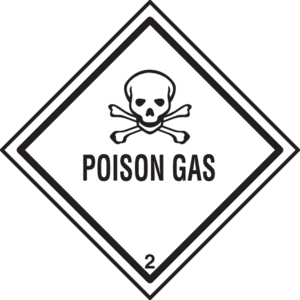 |
|||
|
Flammable Liquids included in Class 3 are included in one of the following packing groups: Packing Group I – if they have an initial boiling point of 35°C or less at an absolute pressure of 101.3kPa and any Flash Point; i.e. diethyl ether or carbon disulfide or Packing Group II – if they have an initial boiling point greater than 35°C at an absolute pressure of 101.3kPa and a Flash Point less than 23°C; i.e. Petrol, Acetone or Packing Group III – if the criteria for inclusion in Packing Group I and II are not met; i.e. Kerosene and Diesel |
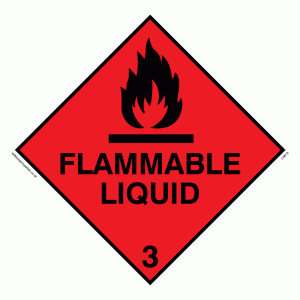 |
|||
|
Flammable Solids: Solid substances that are easily ignited and readily combustible; i.e. nitrocellulose, magnesium, safety matches |
 |
|||
|
Spontaneously Combustible: Solid substances that ignite spontaneously; i.e. Aluminium Alkyls, White Phosphorus |
 |
|||
|
Dangerous When Wet: Solid substances that emit a flammable gas when or react violently with water; i.e. Sodium, Calcium, Potassium, Calcium Carbide |
 |
|||
|
Oxidising Agent: Oxidising agents other than organic peroxides; i.e. calcium, hypochlorite, ammonium nitrate, hydrogen peroxide, potassium permanganate. |
 |
|||
|
Organic Peroxide Oxidising Agent: Either in liquid or solid form; i.e. benzoyl peroxides, cumene |
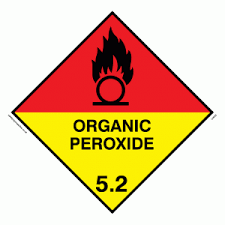 |
|||
|
Fireworks, motor vehicle airbags, distress flares, live or blank ammunition for firearms, smoke bombs, blasting or demolition devices.
|
||||
|
Gas cigarette lighters, gas camping stoves, aerosol cans, welding tanks, breathing apparatus, fire extinguishers, liquid nitrogen shipments, all other forms of gases.
|
||||
|
Gasoline, diesel, kerosene, paints, adhesives, varnish, wood treatment, inks, dyes, alcohol, aftershave lotion, perfumes, food flavorings.
|
||||
|
Matches, fire lighters, naphthalene, phosphorus and metal powders, potassium, calcium carbide, sodium metal.
|
||||
|
Lead dioxide, fertilizers (ammonium nitrate), weed killers (sodium chlorate), swimming pool chemicals.
|
||||
|
Toxic & Infectious Substances: Weed killers, pesticides, disinfectants, viable micro-organisms or toxins that cause disease in animal or humans. |
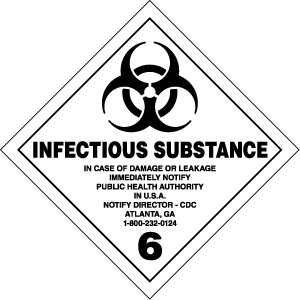 |
|||
|
Radioactive Material: Xenon gas, radioactive medicines. |
 |
|||
|
Corrosives: Battery acids and fluids, bromine and all forms of acids. |
 |
|||
|
Miscellaneous: Dry ice, magnetized materials, self inflating & life saving devices, electric wheelchairs, cosmetics in small inner packaging if they contain aerosols and/or flammable liquids, drugs in small inner packaging if they contain aerosols and/or flammable liquids, polystyrene beads, plastic moulding material, white asbestos, self propelled vehicles, machines incorporating internal combustion engines, dry coconuts and all forms of liquids. |
||||
|
Secondary Hazard Labels |
||||
 |
 |
 |
 |
 |
 |
 |
 |
||
|
Handling Labels |
||||
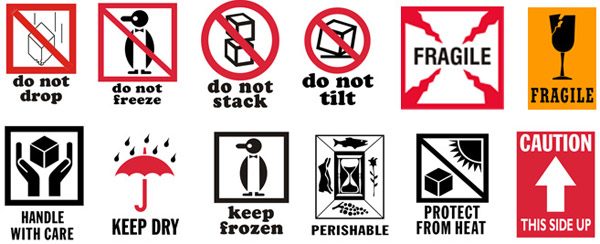 |
||||




